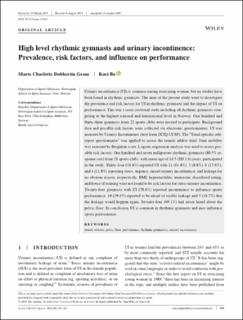| dc.contributor.author | Gram, Marte Charlotte Dobbertin | |
| dc.contributor.author | Bø, Kari | |
| dc.date.accessioned | 2020-05-05T09:26:59Z | |
| dc.date.available | 2020-05-05T09:26:59Z | |
| dc.date.created | 2019-11-12T09:57:55Z | |
| dc.date.issued | 2019 | |
| dc.identifier.citation | Scandinavian Journal of Medicine & Science in Sports. 2020, 30(1), 159-165. | en_US |
| dc.identifier.issn | 0905-7188 | |
| dc.identifier.uri | https://hdl.handle.net/11250/2653303 | |
| dc.description | This is an open access article under the terms of the Creative Commons Attribution‐NonCommercial‐NoDerivs License, which permits use and distribution in any medium, provided the original work is properly cited, the use is non‐commercial and no modifications or adaptations are made. | en_US |
| dc.description.abstract | Urinary incontinence (UI) is common among exercising women, but no studies have been found in rhythmic gymnasts. The aims of the present study were to investigate the prevalence and risk factors for UI in rhythmic gymnasts and the impact of UI on performance. This was a cross‐sectional study including all rhythmic gymnasts competing at the highest national and international level in Norway. One hundred and thirty‐three gymnasts from 22 sports clubs were invited to participate. Background data and possible risk factors were collected via electronic questionnaires. UI was assessed by Urinary Incontinence short form (ICIQ‐UI SF). The "Triad‐specific self‐ report questionnaire" was applied to assess the female athlete triad. Joint mobility was assessed by Beighton score. Logistic regression analysis was used to assess possible risk factors. One hundred and seven nulliparous rhythmic gymnasts (80.5% response rate) from 21 sports clubs, with mean age of 14.5 (SD 1.6) years, participated in the study. Thirty‐four (31.8%) reported UI with 21 (61.8%), 3 (8.8%), 6 (17.6%), and 4 (11.8%) reporting stress, urgency, mixed urinary incontinence, and leakage for no obvious reason, respectively. BMI, hypermobility, menarche, disordered eating, and hours of training were not found to be risk factors for stress urinary incontinence. Twenty‐four gymnasts with UI (70.6%) reported incontinence to influence sports performance; 10 (29.4%) reported to be afraid of visible leakage and 5 (14.7%) that the leakage would happen again. Seventy‐four (69.1%) had never heard about the pelvic floor. In conclusion, UI is common in rhythmic gymnasts and may influence sports performance. | en_US |
| dc.language.iso | eng | en_US |
| dc.subject | female athletes | en_US |
| dc.subject | pelvic floor | en_US |
| dc.subject | performance | en_US |
| dc.subject | rhythmic gymnastics | en_US |
| dc.subject | urinary incontinence | en_US |
| dc.title | High level rhythmic gymnasts and urinary incontinence: Prevalence, risk factors, and influence on performance | en_US |
| dc.type | Peer reviewed | en_US |
| dc.type | Journal article | en_US |
| dc.description.version | publishedVersion | en_US |
| dc.rights.holder | © 2019 The Authors. | en_US |
| dc.source.pagenumber | 7 | en_US |
| dc.source.journal | Scandinavian Journal of Medicine & Science in Sports | en_US |
| dc.identifier.doi | 10.1111/sms.13548 | |
| dc.identifier.cristin | 1746346 | |
| dc.description.localcode | Seksjon for idrettsmedisinske fag / Department of Sports Medicine | en_US |
| cristin.unitcode | 150,34,0,0 | |
| cristin.unitname | Seksjon for idrettsmedisinske fag | |
| cristin.ispublished | true | |
| cristin.fulltext | original | |
| cristin.qualitycode | 2 | |
